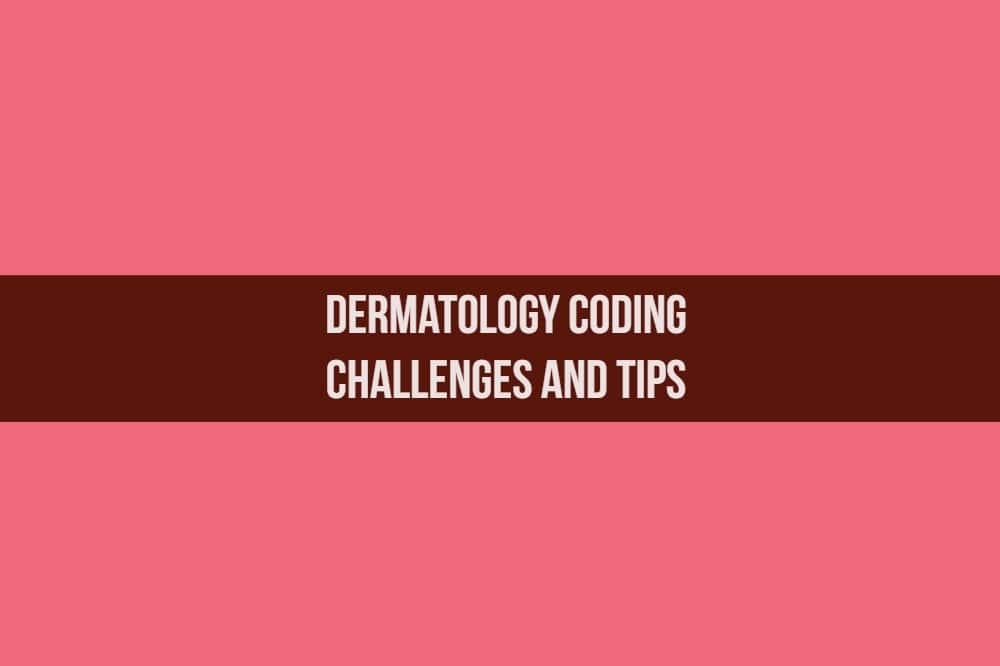Dermatology Coding Challenges
According to ‘Coding 2017 and beyond’, an article published in the Dermatology Times, dermatologists should be prepared for increased audits by Medicare’s CERT (Comprehensive Error Rate Testing) program, OIG, ZPIC and the RAC of their dermatology billing. In order to avoid these increased audits, dermatologists will need to submit detailed documentation which has to include histopathology with Mohs operative notes.
As it is reporting skin procedures is a complex and taxing task. Codes need to be assigned based on the provider’s intent, pathological result, type of removal and size and location of the lesion. While outsourcing the coding and billing to an experienced and professional coding and billing company definitely helps, in order to ensure that the right codes are used, dermatologists need to document their services using the correct terminology.
To successfully code a procedure, it is important for both the dermatologist and the coder to understand and differentiate between different procedures. Let us look at the four most common skin procedures – each distinct from the other and coded differently. Research indicates that improper use of these terms in documentation has resulted in a large proportion of denied claims.
Dermatology Coding Tips for Some Common Procedures
Excision
The complete removal of the skin lesion by cutting through the dermis (full-thickness removal) is documented as an excision. While documenting the excision, the dermatologist must report the size of the lesion at its maximum diameter along with the sum of the narrowest margins used to excise the lesion. Codes for the excision will differ based on whether the lesion is malignant (CPT codes 11600 – 11646) or benign (CPT codes 11400 – 11446). In the case of musculoskeletal procedures, the codes should match (as per the criteria listed in the code descriptor) the description of the excision performed. Further, neuroplasty and/or vessel exploration needs to be reported separately. It is important for the dermatologist to document the depth of the excision to determine whether the CPT codes for musculoskeletal system or integumentary system should be used.
While intermediate and complex closure can be reported additionally, simple closure is always included with excision code and not coded separately. Modifiers need to be used to report multiple excisions. As each lesion excision is treated a separate procedure, a verifiable diagnosis has to be linked with each individual CPT code.
Biopsy
An “independent procedure to obtain tissue for pathologic examination,” a biopsy generally means a part removal of the growth. The purpose of the procedure is to help establish the nature of the lesion where neither definitive clinical nor histologic diagnosis exists. However, it is important to remember that a procedure is coded as a biopsy only if the removal is for diagnosis. In case the entire lesion is removed, it should be coded as an excision.
A biopsy can be done either by shaving, removal by scissors, extraction using a punch and/or excision with a scalpel down to the subcutaneous fat. The first biopsy is coded with the CPT code 11100. For each subsequent biopsy, the CPT code used is 11101. However, remember to submit supporting documentation for multiple skin biopsy performed.
Shave
As per the AMA CPT, shaving is defined as ‘the sharp removal by transverse incision or horizontal slicing to remove epidermal and dermal lesions without a full thickness dermal excision. This includes local anesthesia, chemical or electrocauterization of the wound, and does not require suture closure.’ If there is more than one shaving procedure performed, each shaved lesion is coded and reported separately. While the removed tissue could be sent for a pathological examination, the procedure cannot be coded as a separate procedure. Use CPT codes 11300 – 11313 for coding shaving procedure. Remember, in order to assign the proper code, the dermatologist needs to document the anatomic location and size of the lesion.
Wart and Keratosis Destruction
Treatment of common warts, plantar warts, seborrheic Keratosis and actinic Keratosis is done by the application of acid, laser, freezing or electrocautery. To ensure that maximum reimbursement is received, the dermatologist should document and specify the diagnosis of each different type of wart treated, their location and size. Coding for destruction of common and plantar warts and also benign lesions (other than cutaneous vascular lesions and skin tags) is done using CPT code 17110 and 17111. It is worth remembering that CPT code 17110 is used for up to 14 lesions; whereas 17111 is used when the number of lesions is 15 and above.
MedConverge can help
There have been significant changes in Current Procedural Terminology codes, descriptors, and guidelines that affect dermatologists. Over the years, these changes have involved repair, excision, measuring flap defects, measuring excised diameter, KOH examination, skin biopsy and Mohs surgery guidelines, and fungus cultures. There are new codes for laser treatment, photodynamic therapy, and whole-body photography. Dermatologists have been facing reimbursement issues due to incorrect coding and billing. Some of the common errors in coding and billing have been the failure to recognize the correct modifiers, bundling separate services and multiple procedure reduction.
At MedConverge, our dermatology medical billing specialists not only have a thorough knowledge of skin disease processes and pharmacology, but are also highly trained and certified in CPT, HCPCS and ICD 10 coding systems. To ensure blemish free coding and billing for your practice, contact us at info@medconverge.com
References
- Clements, J. (2018, January 16). How to Code Common Dermatological Skin Procedures. Retrieved November 23, 2018, from www.outsourcestrategies.com: https://www.outsourcestrategies.com/blog/2018/01/how-to-code-common-dermatological-skin-procedures.html
- Documentation and extenders top daily coding challenges . (2018, January 08). Retrieved November 23, 2018, from www.dermatologytimes.com: http://www.dermatologytimes.com/dermatology/documentation-and-extenders-top-daily-coding-challenges
- Rogers, W. (2018, May 24). CPT Codes 2018: Dermatology Coding Updates. Retrieved November 23, 2018, from www.modmed.com: https://www.modmed.com/blog/cpt-codes-2018-dermatology/
- Webb, L.-L. A. (2014, January 08). Documentation challenges for skin and dermatology coding. Retrieved November 23, 2018, from www.hcpro.com: http://www.hcpro.com/HIM-299742-8160/Documentation-challenges-for-skin-and-dermatology-coding.html



